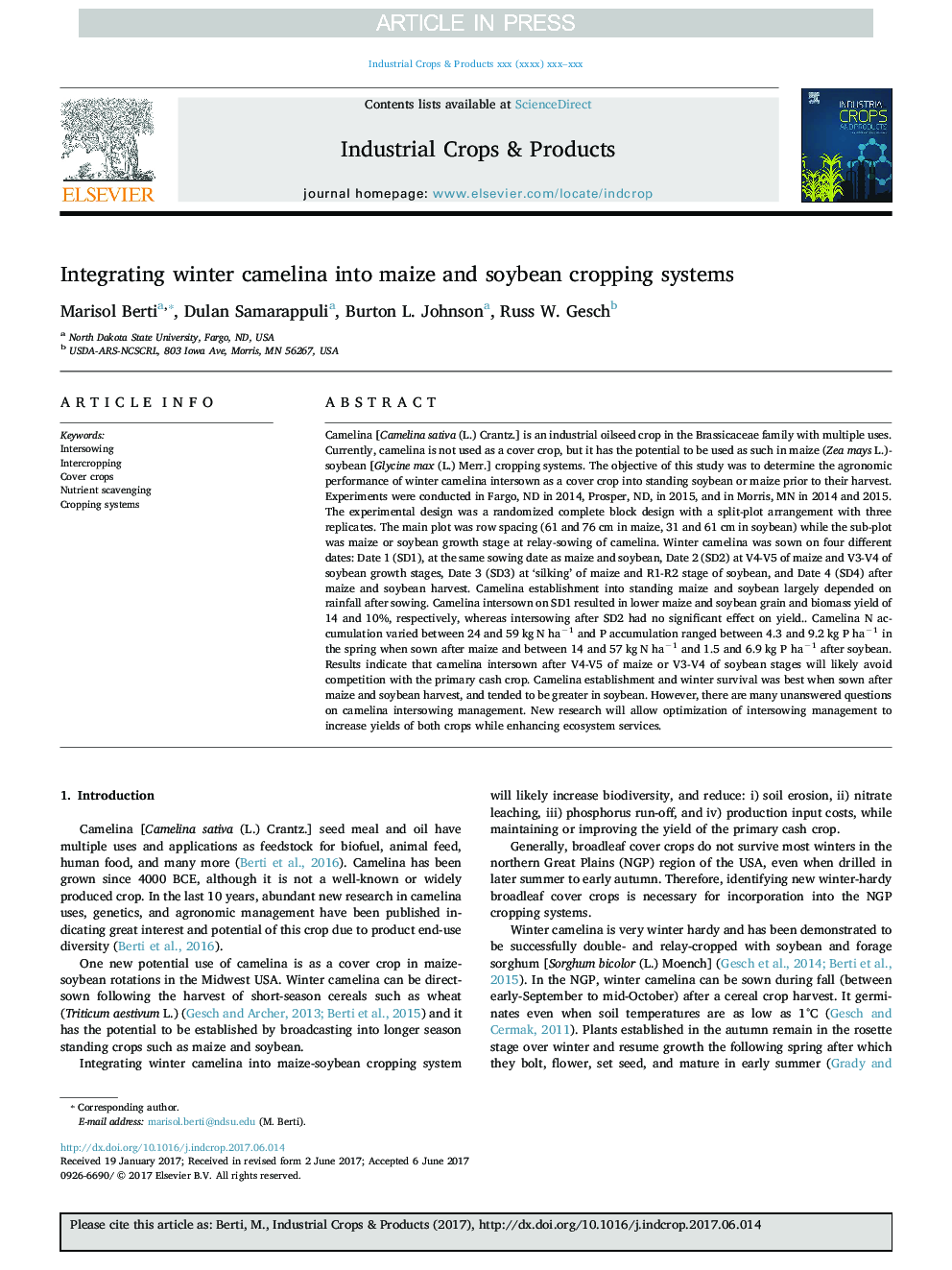| کد مقاله | کد نشریه | سال انتشار | مقاله انگلیسی | نسخه تمام متن |
|---|---|---|---|---|
| 5762045 | 1624803 | 2017 | 7 صفحه PDF | دانلود رایگان |
عنوان انگلیسی مقاله ISI
Integrating winter camelina into maize and soybean cropping systems
ترجمه فارسی عنوان
تلفیق کمپوت زمستانه در سیستم های ذرت و سویا
دانلود مقاله + سفارش ترجمه
دانلود مقاله ISI انگلیسی
رایگان برای ایرانیان
کلمات کلیدی
درونی، کشت مخلوط، پوشش محصولات خوردن مواد مغذی، سیستم های برداشت
موضوعات مرتبط
علوم زیستی و بیوفناوری
علوم کشاورزی و بیولوژیک
علوم زراعت و اصلاح نباتات
چکیده انگلیسی
Camelina [Camelina sativa (L.) Crantz.] is an industrial oilseed crop in the Brassicaceae family with multiple uses. Currently, camelina is not used as a cover crop, but it has the potential to be used as such in maize (Zea mays L.)-soybean [Glycine max (L.) Merr.] cropping systems. The objective of this study was to determine the agronomic performance of winter camelina intersown as a cover crop into standing soybean or maize prior to their harvest. Experiments were conducted in Fargo, ND in 2014, Prosper, ND, in 2015, and in Morris, MN in 2014 and 2015. The experimental design was a randomized complete block design with a split-plot arrangement with three replicates. The main plot was row spacing (61 and 76 cm in maize, 31 and 61 cm in soybean) while the sub-plot was maize or soybean growth stage at relay-sowing of camelina. Winter camelina was sown on four different dates: Date 1 (SD1), at the same sowing date as maize and soybean, Date 2 (SD2) at V4-V5 of maize and V3-V4 of soybean growth stages, Date 3 (SD3) at 'silking' of maize and R1-R2 stage of soybean, and Date 4 (SD4) after maize and soybean harvest. Camelina establishment into standing maize and soybean largely depended on rainfall after sowing. Camelina intersown on SD1 resulted in lower maize and soybean grain and biomass yield of 14 and 10%, respectively, whereas intersowing after SD2 had no significant effect on yield.. Camelina N accumulation varied between 24 and 59 kg N haâ1 and P accumulation ranged between 4.3 and 9.2 kg P haâ1 in the spring when sown after maize and between 14 and 57 kg N haâ1 and 1.5 and 6.9 kg P haâ1 after soybean. Results indicate that camelina intersown after V4-V5 of maize or V3-V4 of soybean stages will likely avoid competition with the primary cash crop. Camelina establishment and winter survival was best when sown after maize and soybean harvest, and tended to be greater in soybean. However, there are many unanswered questions on camelina intersowing management. New research will allow optimization of intersowing management to increase yields of both crops while enhancing ecosystem services.
ناشر
Database: Elsevier - ScienceDirect (ساینس دایرکت)
Journal: Industrial Crops and Products - Volume 107, 15 November 2017, Pages 595-601
Journal: Industrial Crops and Products - Volume 107, 15 November 2017, Pages 595-601
نویسندگان
Marisol Berti, Dulan Samarappuli, Burton L. Johnson, Russ W. Gesch,
